 The OECD has recently published its six-monthly Economic Outlook. This assesses the global economic situation and the prospects for the 38 members of the OECD.
The OECD has recently published its six-monthly Economic Outlook. This assesses the global economic situation and the prospects for the 38 members of the OECD.
It forecasts that the UK economy will bounce back strongly from the deep recession of 2020, when the economy contracted by 9.8 per cent. This contraction was deeper than in most countries, with the USA contracting by 3.5 per cent, Germany by 5.1 per cent, France by 8.2 per cent, Japan by 4.7 per cent and the OECD as a whole by 4.8 per cent. But, with the success of the vaccine roll-out, UK growth in 2021 is forecast by the OECD to be 7.2 per cent, which is higher than in most other countries. The USA is forecast to grow by 6.8 per cent, Germany by 3.3 per cent, France by 5.8 per cent, Japan by 2.6 per cent and the OECD as a whole by 5.3 per cent. Table 1 in the Statistical Annex gives the figures.
This good news for the UK, however, is tempered by some worrying features.
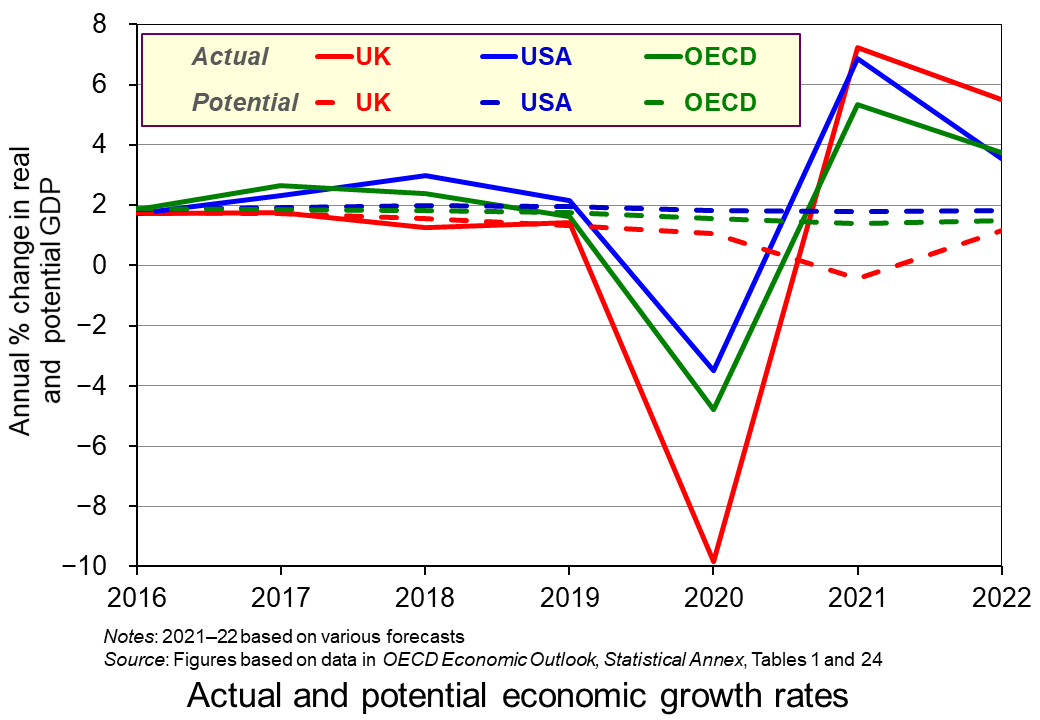 The OECD forecasts that potential economic growth will be negative in 2021, with capacity declining by 0.4 per cent. Only two other OECD countries, Italy and Greece, are forecast to have negative potential economic growth (see Table 24 in the Statistical Annex). A rapid increase in aggregate demand, accompanied by a decline in aggregate supply, could result in inflationary pressures, even if initially there is considerable slack in some parts of the economy.
The OECD forecasts that potential economic growth will be negative in 2021, with capacity declining by 0.4 per cent. Only two other OECD countries, Italy and Greece, are forecast to have negative potential economic growth (see Table 24 in the Statistical Annex). A rapid increase in aggregate demand, accompanied by a decline in aggregate supply, could result in inflationary pressures, even if initially there is considerable slack in some parts of the economy.
Part of the reason for the supply constraints are the additional barriers to trade with the EU resulting from Brexit. The extra paperwork for exporters has added to export costs, and rules-of-origin regulations add tariffs to many exports to the EU (see the blog A free-trade deal? Not really). Another supply constraint linked to Brexit is the shortage of labour in certain sectors, such as hospitality, construction and transport. With many EU citizens having left the UK and not being replaced by equivalent numbers of new immigrants, the problem is likely to persist.
 The scarring effects of the pandemic present another problem. There has been a decline in investment. Even if this is only temporary, it will have a long-term impact on capacity, unless there is a compensating rise in investment in the future. Many businesses have closed and will not re-open, including many High Street stores. Moves to working from home, even if partially reversed as the economy unlocks, will have effects on the public transport industry. Also, people may have found new patterns of consumption, such as making more things for themselves rather than buying them, which could affect many industries. It is too early to predict the extent of these scarring effects and how permanent they will be, but they could have a dampening effect on certain sectors.
The scarring effects of the pandemic present another problem. There has been a decline in investment. Even if this is only temporary, it will have a long-term impact on capacity, unless there is a compensating rise in investment in the future. Many businesses have closed and will not re-open, including many High Street stores. Moves to working from home, even if partially reversed as the economy unlocks, will have effects on the public transport industry. Also, people may have found new patterns of consumption, such as making more things for themselves rather than buying them, which could affect many industries. It is too early to predict the extent of these scarring effects and how permanent they will be, but they could have a dampening effect on certain sectors.
Inflation
So will inflation take off, or will it remain subdued? At first sight it would seem that inflation is set to rise significantly. Annual CPI inflation rose from 0.7 per cent in March 2021 to 1.5 per cent in April, with the CPI rising by 0.6 per cent in April alone. What is more, the housing market has seen a large rise in demand, with annual house price inflation reaching 10.2 per cent in March.
But these rises have been driven by some one-off events. As the economy began unlocking, so spending rose dramatically. While this may continue for a few months, it may not persist, as an initial rise in household spending may reflect pent-up demand and as the furlough scheme comes to an end in September.
 As far as as the housing market is concerned, the rise in demand has been fuelled by the stamp duty ‘holiday’ which exempts residential property purchase from Stamp Duty Land Tax for properties under £500 000 in England and Northern Ireland and £250 000 in Scotland and Wales (rather than the original £125 000 in England and Northern Ireland, £145 000 in Scotland and £180 000 in Wales). In England and Northern Ireland, this limit is due to reduce to £250 000 on 30 June and back to £125 000 on 30 September. In Scotland the holiday ended on 31 March and in Wales is due to end on 30 June. As these deadlines are passed, this should see a significant cooling of demand.
As far as as the housing market is concerned, the rise in demand has been fuelled by the stamp duty ‘holiday’ which exempts residential property purchase from Stamp Duty Land Tax for properties under £500 000 in England and Northern Ireland and £250 000 in Scotland and Wales (rather than the original £125 000 in England and Northern Ireland, £145 000 in Scotland and £180 000 in Wales). In England and Northern Ireland, this limit is due to reduce to £250 000 on 30 June and back to £125 000 on 30 September. In Scotland the holiday ended on 31 March and in Wales is due to end on 30 June. As these deadlines are passed, this should see a significant cooling of demand.
Finally, although the gap between potential and actual output is narrowing, there is still a gap. According to the OECD (Table 12) the output gap in 2021 is forecast to be −4.6 per cent. Although it was −11.4 per cent in 2020, a gap of −4.6 per cent still represents a significant degree of slack in the economy.
At the current point in time, therefore, the Bank of England does not expect to have to raise interest rates in the immediate future. But it stands ready to do so if inflation does show signs of taking off.
Articles
- United Kingdom Economic Snapshot
OECD Economic Outlook (May 2021)
- UK growth forecast upgraded but pandemic economic ‘scar’ will be worst of all G7 nations, says OECD
Sky News, Ed Conway (31/5/21)
- OECD Predicts UK Economic Growth Amid Vaccine Success And Lockdown Easing
Minutehack Emma Bowden (1/6/21)
- UK growth upgraded, but OECD warns of deepest economic scar in G7
The Guardian, Graeme Wearden (31/5/21)
- UK set for stronger post-Covid recovery, says OECD
BBC News (31/5/21)
- British exports worth billions have faced EU tariffs since Brexit
BBC News, Faisal Islam (28/5/21)
 Post-Brexit: Businesses hit by labour shortages call for Brexit rules to be relaxed
Post-Brexit: Businesses hit by labour shortages call for Brexit rules to be relaxedChannel 4 News, Paul McNamara (2/6/21)
- Bank of England monitors UK housing boom as it weighs inflation risk
The Guardian, Larry Elliott (1/6/21)
- House prices jump 10.9% as ‘race for space’ intensifies
BBC News (1/6/21)
- Global food prices post biggest jump in decade
Financial Times, Emiko Terazono and Judith Evans (3/6/21)
- Why house prices are rising so fast in a pandemic
BBC News, Kevin Peachey and Daniele Palumbo (2/6/21)
- Inflation: why it could surge after the pandemic
The Conversation, Ian Crowther (23/4/21)
- Inflation might well keep rising in 2021 – but what happens after that?
The Conversation, Brigitte Granville (31/5/21)
- Slack in the Economy, Not Inflation, Should Be Bigger Worry
Institute for New Economic Thinking, Claudia Fontanari, Antonella Palumbo, and Chiara Salvatori (19/5/21)
Data, Forecasts and Analysis
Questions
- What determines the rate of (a) actual economic growth; (b) potential economic growth?
- What is meant by an output gap? What would be the implications of a positive output gap?
- Why are scarring effects of the pandemic likely to be greater in the UK than in most other countries?
- If people believed that inflation was likely to continue rising, how would this affect their behaviour and how would it affect the economy?
- What are the arguments for and against having a stamp duty holiday when the economy is in recession?
 Would you like to be a millionaire? Of course you would – who wouldn’t, right? Actually the answer to this question may be more complicated than you might think (see for instance Sgroi et al (2017) on the economics of happiness: see linked article below), but, generally speaking, most people would answer positively to this question.
Would you like to be a millionaire? Of course you would – who wouldn’t, right? Actually the answer to this question may be more complicated than you might think (see for instance Sgroi et al (2017) on the economics of happiness: see linked article below), but, generally speaking, most people would answer positively to this question.
What if I told you, however, that you could become a millionaire (actually, scratch that – think big – make that “trillionaire”) overnight and be deeply unhappy about it? If you don’t believe me see what happened to Zimbabwe 10 years ago, when irresponsible money printing and fiscal easing drove the country’s economy to staggering hyperinflation (see the blogs A remnant of hyperinflation in Zimbabwe and Fancy a hundred trillion dollar note?. At the peak of the crisis, prices were increasing by a factor of 130 each year. I have in my office a 100 trillion Zimbabwean dollar note (see below) which I show in my lectures when I talk about hyperinflation to my first year Economics for Business students (if you are one of them, make sure not to miss it next February at UEA!). How much is this 100 trillion note worth? Nothing (except, may be, for collectors). It has been withdrawn from circulation as it ended up not even being worth the cost of the paper on which it was printed.
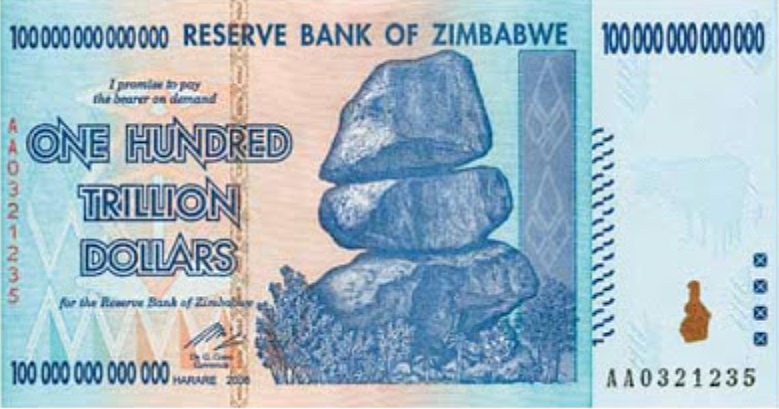
The Zimbabwean economy managed to pull itself out of this spiral of economic death, partly by informally replacing its hyperinflationary currency with the US greenback, and partly by keeping its fiscal spending under control and reverting to more sane economic policy making. That lasted until 2013, after which the government launched a Zimbabwean digital currency (known as “Zollar”) that had a nominal value set equal to a US dollar; and forced its exporters to exchange their greenbacks for Zollars. It then started spending these USD to finance a very ambitious and unsustainable programme of fiscal expansion.
The Economist published yesterday a story that shows the results of this policy – wild price increases and empty supermarket shelves are both back. According to the newspaper’s report:
At a supermarket in Harare, Zimbabwe’s capital, the finance minister is staring aghast at a pack of nappies. ‘This is absolutely ridiculous!’, exclaims Mthuli Ncube. ‘$49!’ A manager says it cost $23 two weeks ago, before pointing out other eye-watering items such as $20 Coco Pops. […] Over the past two weeks zollars have been trading at as little as 17 cents to the dollar. The devaluation has led to a surge in prices—and not just in imported goods like nappies. Football fans attending the Zimbabwe v Democratic Republic of Congo game on October 16th were shocked to learn that ticket prices had doubled on match day.
How long will it take for the 100 trillion Zollar to make its appearance again? We shall find out. I am sure Zimbabweans will be less than thrilled!
Articles and Report
- A fist full of zollars: Zimbabwe’s shops are empty and prices are soaring
The Economist (28/10/18)
- Shelves Empty as Specter of Hyperinflation Stalks Zimbabwe
Bloomberg, Paul Wallace, Godfrey Marawanyika and Desmond Kumbuka (12/10/18)
- imbabwe currency crisis: No cash, no bread, no KFC
BBC News, Andrew Harding (12/10/18)
- Hyperinflation in Zimbabwe: money demand, seigniorage and aid shocks
Journal of Applied Economics, Tara McIndoe-Calder (Volume 50, Issue 15, 18/9/17)
- Understanding Happiness
A CAGE Policy Report: Social Market Foundation, Daniel Sgroi, Thomas Hills, Gus O’Donnell, Andrew Oswald and Eugenio Proto (January 2017)
Videos
Questions
- Using an AS/AD diagram, explain the concept of hyperinflation. How can irresponsible fiscal policy-making lead to hyperinflation?
- What are the effects of hyperinflation on the people who live in the affected countries? Search the web for examples and case studies, and use them to support your answer.
- Once it has started, what policies can be used to fight hyperinflation? Use examples to support your answer.
- How does speculation affect hyperinflation?
 On 8 February, the Bank of England issued a statement that was seen by many as a warning for earlier and speedier than previously anticipated increases in the UK base rate. Mark Carney, the governor of the Bank of England, referred in his statement to ‘recent forecasts’ which make it more likely that ‘monetary policy would need to be tightened somewhat earlier and by a somewhat greater extent over the forecast period than anticipated at the time of the November report’.
On 8 February, the Bank of England issued a statement that was seen by many as a warning for earlier and speedier than previously anticipated increases in the UK base rate. Mark Carney, the governor of the Bank of England, referred in his statement to ‘recent forecasts’ which make it more likely that ‘monetary policy would need to be tightened somewhat earlier and by a somewhat greater extent over the forecast period than anticipated at the time of the November report’.
A similar picture emerges on the other side of the Atlantic. With labour markets continuing to deliver spectacularly high rates of employment (the highest in the last 17 years), there are also now signs that wages are on an upward trajectory. According to a recent report from the US Bureau of Labor Statistics, US wage growth has been stronger than expected, with average hourly earnings rising by 2.9 percent – the strongest growth since 2009.
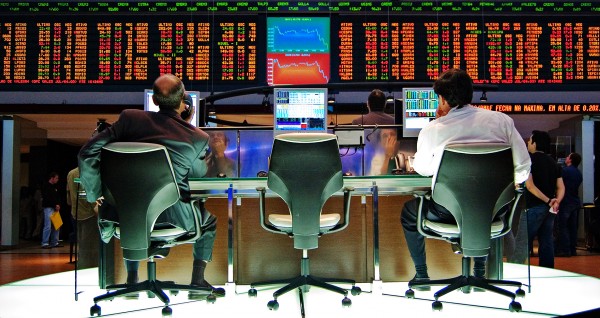 These statements have coincided with a week of sharp corrections and turbulence in the world’s largest capital markets, as investors become increasingly conscious of the threat of rising inflation – and the possibility of tighter monetary policy.
These statements have coincided with a week of sharp corrections and turbulence in the world’s largest capital markets, as investors become increasingly conscious of the threat of rising inflation – and the possibility of tighter monetary policy.
The Dow Jones plunged from an all-time high of 26,186 points on 1 February to 23,860 a week later – losing more than 10 per cent of its value in just five trading sessions (suffering a 4.62 percentag fall on 5 February alone – the worst one-day point fall since 2011). European and Asian markets followed suit, with the FTSE-100, DAX and NIKKEI all suffering heavy losses in excess of 5 per cent over the same period.
 But why should higher inflationary expectations fuel a sell-off in global capital markets? After all, what firm wouldn’t like to sell its commodities at a higher price? Well, that’s not entirely true. Investors know that further increases in inflation are likely to be met by central banks hiking interest rates. This is because central banks are unlikely to be willing or able to allow inflation rates to rise much above their target levels.
But why should higher inflationary expectations fuel a sell-off in global capital markets? After all, what firm wouldn’t like to sell its commodities at a higher price? Well, that’s not entirely true. Investors know that further increases in inflation are likely to be met by central banks hiking interest rates. This is because central banks are unlikely to be willing or able to allow inflation rates to rise much above their target levels.
The Bank of England, for instance, sets itself an inflation target of 2%. The actual ongoing rate of inflation reported in the latest quarterly Inflation Report is 3% (50 per cent higher than the target rate).
Any increase in interest rates is likely to have a direct impact on both the demand and the supply side of the economy.
Consumers (the demand side) would see their cost of borrowing increase. This could put pressure on households that have accumulated large amounts of debt since the beginning of the recession and could result in lower consumer spending.
Firms (the supply side) are just as likely to suffer higher borrowing costs, but also higher operational costs due to rising wages – both of which could put pressure on profit margins.
It now seems more likely that we are coming towards the end of the post-2008 era – a period that saw the cost of money being driven down to unprecedentedly low rates as the world’s largest economies dealt with the aftermath of the Great Recession.
For some, this is not all bad news – as it takes us a step closer towards a more historically ‘normal’ equilibrium. It remains to be seen how smooth such a transition will be and to what extent the high-leveraged world economy will manage to keep its current pace, despite the increasingly hawkish stance in monetary policy by the world’s biggest central banks.
Video
 Dow plunges 1,175 – worst point decline in history CNN Money, Matt Egan (5/2/18)
Dow plunges 1,175 – worst point decline in history CNN Money, Matt Egan (5/2/18)
Articles
Global Markets Shed $5.2 Trillion During the Dow’s Stock Market Correction Fortune, Lucinda Shen (9/2/18)
Bank of England warns of larger rises in interest rates Financial Times, Chris Giles and Gemma Tetlow (8/2/18)
Stocks are now in a correction — here’s what that means Business Insider, Andy Kiersz (8/2/18)
US economy adds 200,000 jobs in January and wages rise at fastest pace since recession Business Insider, Akin Oyedele (2/2/18)
Questions
- Using supply and demand diagrams, explain the likely effect of an increase in interest rates to equilibrium prices and output. Is it good news for investors and how do you expect them to react to such hikes? What other factors are likely to influence the direction of the effect?
- Do you believe that the current ultra-low interest rates could stay with us for much longer? Explain your reasoning.
- What is likely to happen to the exchange rate of the pound against the US dollar, if the Bank of England increases interest rates first?
- Why do stock markets often ‘overshoot’ in responding to expected changes in interest rates or other economic variables
 UK CPI inflation rose to 3.1% in November. This has forced Mark Carney to write a letter of explanation to the Chancellor – something he is required to do if inflation is more than 1 percentage point above (or below) the target of 2%.
UK CPI inflation rose to 3.1% in November. This has forced Mark Carney to write a letter of explanation to the Chancellor – something he is required to do if inflation is more than 1 percentage point above (or below) the target of 2%.
The rise in inflation over the past few months has been caused largely by the depreciation of sterling following the Brexit vote. But there have been other factors at play too. The dollar price of oil has risen by 32% over the past 12 months and there have been large international rises in the price of metals and, more recently, in various foodstuffs. For example, butter prices have risen by over 20% in the past year (although they have declined somewhat recently). Other items that have seen large price rises include books, computer games, clothing and public transport.
The rate of CPI inflation is the percentage increase in the consumer prices index over the previous 12 months. When there is a one-off rise in prices, such as a rise in oil prices, its effect on inflation will only last 12 months. After that, assuming the price does not rise again, there will be no more effect on inflation. The CPI will be higher, but inflation will fall back. The effect may not be immediate, however, as input price changes take a time to work through supply chains.
Given that the main driver of inflation has been the depreciation in sterling, once the effect has worked through in terms of higher prices, inflation will fall back. Only if sterling continued depreciating would an inflation effect continue. So, many commentators are expecting that the rate on inflation will soon begin to fall.
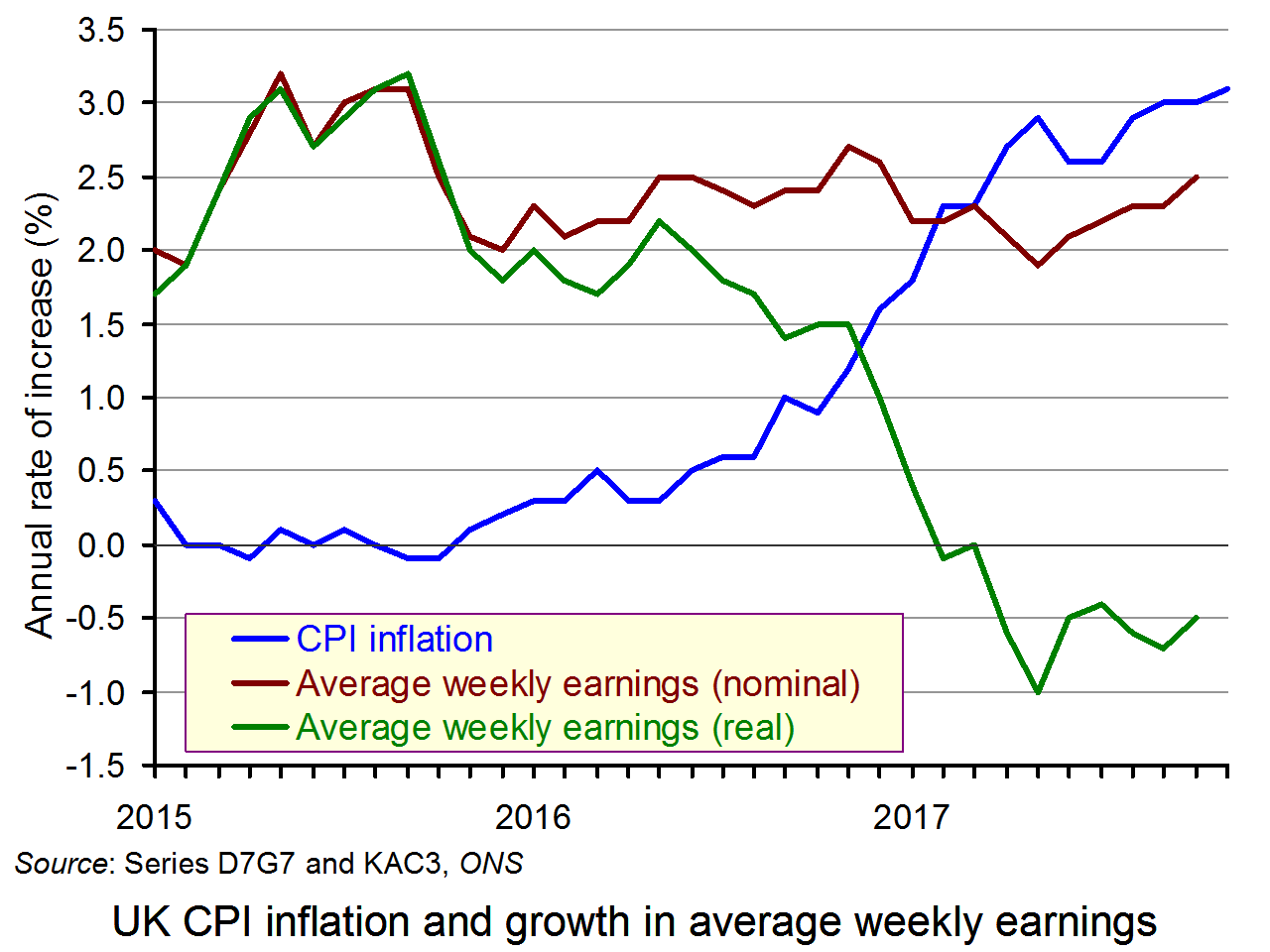 But what will have been the effect on real incomes? In the past 12 months, nominal average earnings have risen by around 2.5% (the precise figures will not be available for a month). This means that real average earnings have fallen by around 0.6%. (Click here for a PowerPoint of the chart.)
But what will have been the effect on real incomes? In the past 12 months, nominal average earnings have risen by around 2.5% (the precise figures will not be available for a month). This means that real average earnings have fallen by around 0.6%. (Click here for a PowerPoint of the chart.)
For many low-income families the effect has been more severe. Many have seen little or no increase in their pay and they also consume a larger proportion of items whose prices have risen by more than the average. Those on working-age benefits will be particularly badly hit as benefits have not risen since 2015.
If inflation does fall and if real incomes no longer fall, people will still be worse off unless real incomes rise back to the levels they were before they started falling. That could be some time off.
Articles
UK inflation rate at near six-year high BBC News (12/12/17)
Inflation up as food costs jump – and gas crisis threatens worse to come The Telegraph, Tim Wallace (12/12/17)
UK worst for pay growth as rich world soars ahead in 2018 The Telegraph, Tim Wallace (12/12/17)
Inflation rises to 3.1%, adding to UK cost of living squeeze The Guardian, Larry Elliott (12/12/17)
UK inflation breaches target as it climbs to 3.1% Financial Times, Gavin Jackson (12/12/17)
Inflation surges to 3.1% in November, a near six-year high Belfast Telegraph (12/12/17)
Data
CPI annual rate of increase (all items) ONS: series D7G7
Average weekly earnings, annual (3-month average) ONS: series KAC3
UK consumer price inflation: November 2017 ONS Statistical Bulletin (12/12/17)
Commodity prices Index Mundi
Questions
- Apart from CPI inflation, what other measures of inflation are there? Explain their meaning.
- Why is inflation of 2%, rather than 0%, seen as the optimal rate by most central banks?
- Apart from the depreciation of sterling, what other effects is Brexit likely to have on living standards in the UK?
- What are the arguments for and against the government raising benefits by the rate of CPI inflation?
- If Europe and the USA continue to grow faster than the UK, what effect is this likely to have on the euro/pound and dollar/pound exchange rates? What determines the magnitude of this effect?
- Unemployment is at its lowest level since 1975. Why, then, are real wages falling?
- Why, in the light of inflation being above target, has the Bank of England not raised Bank Rate again in December (having raised it from 0.25% to 0.5% in November)?
 On the 15th June, the Bank of England’s Monetary Policy Committee decided to keep Bank Rate on hold at its record low of 0.25%. This was not a surprise – it was what commentators had expected. What was surprising, however, was the split in the MPC. Three of its current eight members voted to raise the rate.
On the 15th June, the Bank of England’s Monetary Policy Committee decided to keep Bank Rate on hold at its record low of 0.25%. This was not a surprise – it was what commentators had expected. What was surprising, however, was the split in the MPC. Three of its current eight members voted to raise the rate.
At first sight, raising the rate might seem the obvious thing to do. CPI inflation is currently 2.9% – up from 2.7% in April and well above the target of 2% – and is forecast to go higher later this year. According to the Bank of England’s own forecasts, even at the 24-month horizon inflation is still likely to be a little above the 2% target.
Those who voted for an increase of 0.25 percentage points to 0.5% saw it as modest, signalling only a very gradual return to more ‘normal’ interest rates. However, the five who voted to keep the rate at 0.25% felt that it could dampen demand too much.
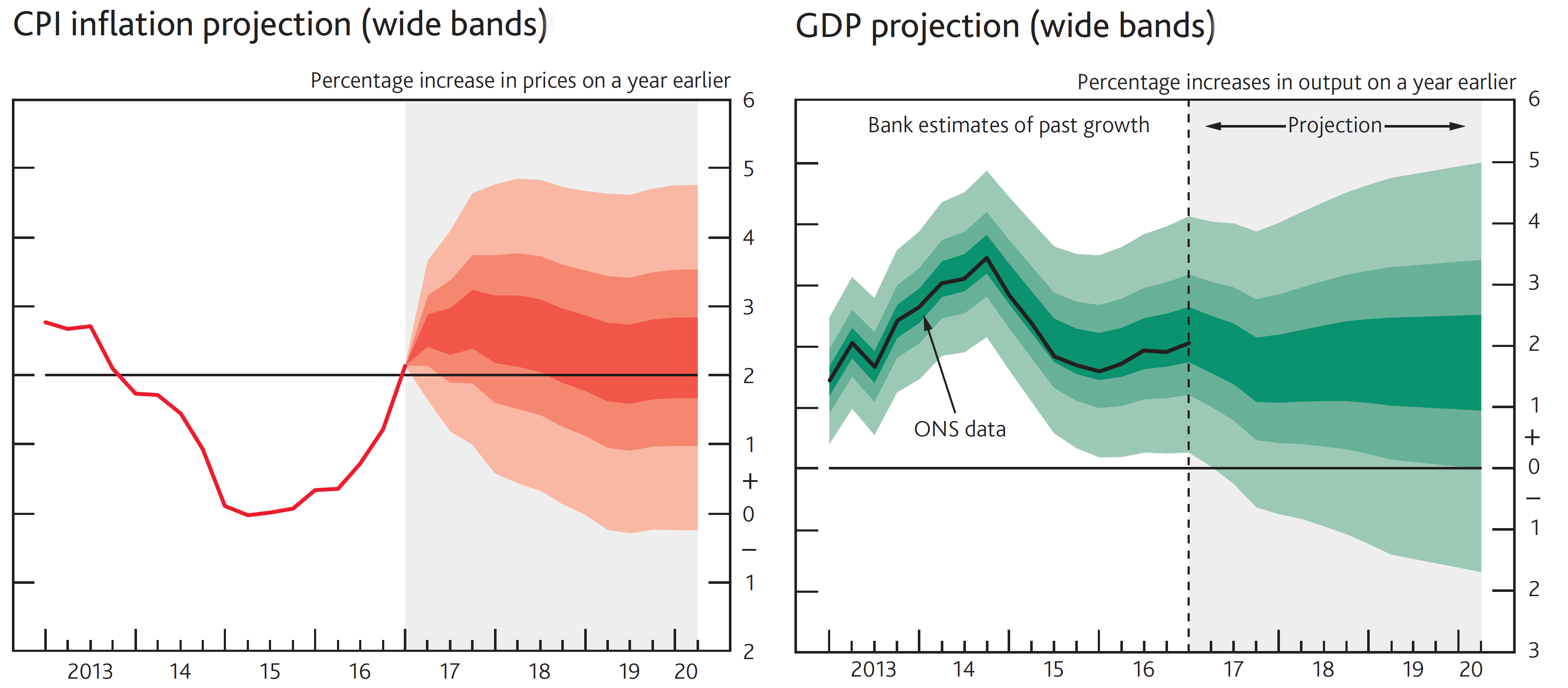
The key argument is that inflation is not of the demand-pull variety. Aggregate demand is subdued. Real wages are falling and hence consumer demand is likely to fall too. Thus many firms are cautious about investing, especially given the considerable uncertainties surrounding the nature of Brexit. The prime cause of the rise in inflation is the fall in sterling since the Brexit vote and the effect of higher import costs feeding through into retail prices. In other words, the inflation is of the cost-push variety. In such cirsumstances dampening demand further by raising interest rates would be seen by most economists as the wrong response. As the minutes of the MPC meeting state:
Attempting to offset fully the effect of weaker sterling on inflation would be achievable only at the cost of higher unemployment and, in all likelihood, even weaker income growth. For this reason, the MPC’s remit specifies that, in such exceptional circumstances, the Committee must balance any trade-off between the speed at which it intends to return inflation sustainably to the target and the support that monetary policy provides to jobs and activity.
The MPC recognises that the outlook is uncertain. It states that it stands ready to respond to circumstances as they change. If demand proves to be more resilient that it currently expects, it will raise Bank Rate. If not, it is likely to keep it on hold to continue providing a modest stimulus to the economy. However, it is unlikely to engage in further quantitative easing unless the economic outlook deteriorates markedly.
Articles
The Bank of England is moving closer to killing the most boring chart in UK finance right now Business Insider, Will Martin (16/6/17)
UK inflation hits four-year high of 2.9% Financial Times, Gavin Jackson and Chloe Cornish (13/6/17)
Surprise for markets as trio of Bank of England gurus call for interest rates to rise The Telegraph, Szu Ping Chan Tim Wallace (15/6/17)
Bank of England rate setters show worries over rising inflation Financial TImes, Chris Giles (15/6/17)
Three Bank of England policymakers in shock vote for interest rate rise Independent, Ben Chu (15/6/17)
Bank of England edges closer to increasing UK interest rates The Guardian, Katie Allen (15/6/17)
Bank of England doves right to thwart hawks seeking interest rate rise The Guardian, Larry Elliott (15/6/17)
Haldane expects to vote for rate rise this year BBC News (21/6/17)
Bank of England documents
Monetary policy summary Bank of England (15/6/17)
Monetary Policy Summary and minutes of the Monetary Policy Committee meeting ending on 14 June 2017 Bank of England (15/6/17)
Inflation Report, May 2017 Bank of England (11/5/16)
Questions
- What is the mechanism whereby a change in Bank Rate affects other interest artes?
- Use an aggregate demand and supply diagram to illustrate the difference between demand-pull and cost-push inflation.
- If the exchange rate remains at around 10–15% below the level before the Brexit vote, will inflation continue to remain above the Bank of England’s target, or will it reach a peak relatively soon and then fall back? Explain.
- For what reason might aggregate demand prove more buoyant that the MPC predicts?
- Would a rise in Bank Rate from 0.25% to 0.5% have a significant effect on aggregate demand? What role could expectations play in determining the nature and size of the effect?
- Why are real wage rates falling at a time when unemployment is historically very low?
- What determines the amount that higher prices paid by importers of products are passed on to consumers?
 The OECD has recently published its six-monthly Economic Outlook. This assesses the global economic situation and the prospects for the 38 members of the OECD.
The OECD has recently published its six-monthly Economic Outlook. This assesses the global economic situation and the prospects for the 38 members of the OECD.  The OECD forecasts that potential economic growth will be negative in 2021, with capacity declining by 0.4 per cent. Only two other OECD countries, Italy and Greece, are forecast to have negative potential economic growth (see Table 24 in the Statistical Annex). A rapid increase in aggregate demand, accompanied by a decline in aggregate supply, could result in inflationary pressures, even if initially there is considerable slack in some parts of the economy.
The OECD forecasts that potential economic growth will be negative in 2021, with capacity declining by 0.4 per cent. Only two other OECD countries, Italy and Greece, are forecast to have negative potential economic growth (see Table 24 in the Statistical Annex). A rapid increase in aggregate demand, accompanied by a decline in aggregate supply, could result in inflationary pressures, even if initially there is considerable slack in some parts of the economy. The scarring effects of the pandemic present another problem. There has been a decline in investment. Even if this is only temporary, it will have a long-term impact on capacity, unless there is a compensating rise in investment in the future. Many businesses have closed and will not re-open, including many High Street stores. Moves to working from home, even if partially reversed as the economy unlocks, will have effects on the public transport industry. Also, people may have found new patterns of consumption, such as making more things for themselves rather than buying them, which could affect many industries. It is too early to predict the extent of these scarring effects and how permanent they will be, but they could have a dampening effect on certain sectors.
The scarring effects of the pandemic present another problem. There has been a decline in investment. Even if this is only temporary, it will have a long-term impact on capacity, unless there is a compensating rise in investment in the future. Many businesses have closed and will not re-open, including many High Street stores. Moves to working from home, even if partially reversed as the economy unlocks, will have effects on the public transport industry. Also, people may have found new patterns of consumption, such as making more things for themselves rather than buying them, which could affect many industries. It is too early to predict the extent of these scarring effects and how permanent they will be, but they could have a dampening effect on certain sectors. As far as as the housing market is concerned, the rise in demand has been fuelled by the stamp duty ‘holiday’ which exempts residential property purchase from Stamp Duty Land Tax for properties under £500 000 in England and Northern Ireland and £250 000 in Scotland and Wales (rather than the original £125 000 in England and Northern Ireland, £145 000 in Scotland and £180 000 in Wales). In England and Northern Ireland, this limit is due to reduce to £250 000 on 30 June and back to £125 000 on 30 September. In Scotland the holiday ended on 31 March and in Wales is due to end on 30 June. As these deadlines are passed, this should see a significant cooling of demand.
As far as as the housing market is concerned, the rise in demand has been fuelled by the stamp duty ‘holiday’ which exempts residential property purchase from Stamp Duty Land Tax for properties under £500 000 in England and Northern Ireland and £250 000 in Scotland and Wales (rather than the original £125 000 in England and Northern Ireland, £145 000 in Scotland and £180 000 in Wales). In England and Northern Ireland, this limit is due to reduce to £250 000 on 30 June and back to £125 000 on 30 September. In Scotland the holiday ended on 31 March and in Wales is due to end on 30 June. As these deadlines are passed, this should see a significant cooling of demand. Post-Brexit: Businesses hit by labour shortages call for Brexit rules to be relaxed
Post-Brexit: Businesses hit by labour shortages call for Brexit rules to be relaxed Would you like to be a millionaire? Of course you would – who wouldn’t, right? Actually the answer to this question may be more complicated than you might think (see for instance Sgroi et al (2017) on the economics of happiness: see linked article below), but, generally speaking, most people would answer positively to this question.
Would you like to be a millionaire? Of course you would – who wouldn’t, right? Actually the answer to this question may be more complicated than you might think (see for instance Sgroi et al (2017) on the economics of happiness: see linked article below), but, generally speaking, most people would answer positively to this question.





